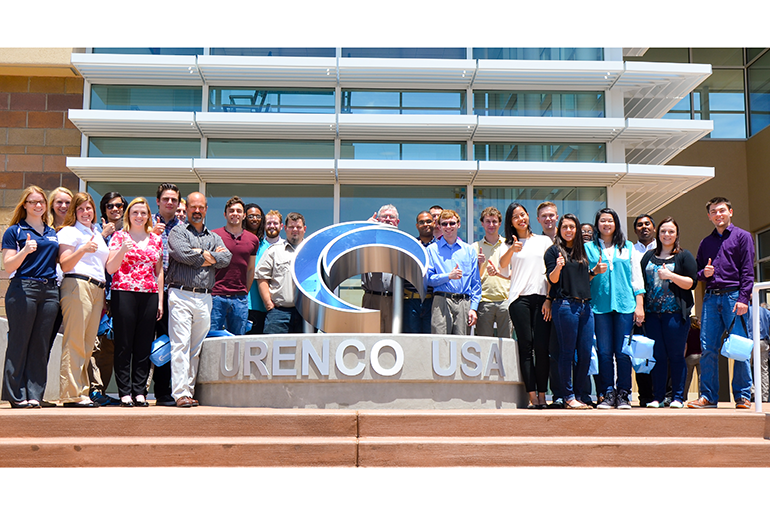
Students from the Texas A&M University Department of Nuclear Engineering and Prairie View A&M University (PVAMU) participated in the 4th annual domestic Nuclear Facilities Experience (NFE) May 17- 23. This was the first year that the NFE included students from another Texas A&M University System partner. This year’s NFE included visits to an extensive range of nuclear sites throughout New Mexico and Texas, including the Urenco uranium enrichment plant, Sandia National Laboratories, Los Alamos National Laboratory, and the Pantex nuclear weapons assembly and disassembly facility.
"The NFE was a wonderful opportunity that gave students the chance to go out and see what the nuclear engineering field is really about,” said PVAMU senior Dahvien Dean, who participated in the tours.
Texas A&M Engineering Experiment Station’s Nuclear Security Science and Policy Institute (NSSPI) organized the event jointly with faculty from the Texas A&M Department of Nuclear Engineering and PVAMU. The students were accompanied by PVAMU faculty and Texas A&M coordinators Dr. Craig Marianno, NSSPI senior research engineer and visiting professor in the Department of Nuclear Engineering, and Dr. Royal Elmore, NSSPI research assistant. Texas A&M students’ participation in the NFE was funded through support from the Department of Nuclear Engineering. PVAMU students and faculty attended the NFE as part of a Nuclear Forensics for Minority Serving Institutions grant, which was awarded to PVAMU by the U.S. Department of Homeland Security’s Domestic Nuclear Detection Office. NSSPI and Los Alamos have been key collaborators on this project.
The NFE began at the Urenco USA uranium enrichment facility in Eunice, New Mexico, where the site’s president gave the group a short welcome before their tour of the facility. Urenco provided an array of managers across its functional areas to interact with the students during their visit. Participants saw the uranium hexafluoride feed and withdrawal stations, cascade hall, support equipment and control room.
"Urenco provided a wonderful opportunity for nuclear engineering students to experience the inner workings of a uranium enrichment facility," said Steven Horowitz, a Texas A&M graduate student on the tour.
The group then visited Sandia, where they toured the museum and visited the reactor, the cobalt irradiation system, the critical experiments site, and the centrifuge center. "The Sandia museum and facility tours were great and led by very dedicated and engaging Sandia staff and scientists," Marianno said.
The sites visited at Sandia covered a range of interests from power systems to health physics to chemical engineering and appealed to a wide student audience. Sandia, and in particular Integrated Military Systems director David Keese and his staff, have been strong ongoing partners in the NFE.
The Los Alamos visit began at the Bradbury museum with a talk by a lab historian. Dr. Joseph Martz then gave an insightful account of the Los Alamos site and took the group on a guided bus tour. PVAMU coordinator Dr. Richard Wilkins said, "To have someone of Dr. Martz’s experience and stature spend the time that he did with our group was tremendous, and it was fascinating listening to his narration during the museum visit and bus tour."
The group attended lectures by Los Alamos staff members on post-detonation nuclear forensics, the Goiania incident, nuclear policy, student opportunities at Los Alamos, and the International Atomic Energy Agency inspection process.
The students then participated in the Institute for Nuclear Materials Management (INMM) Taos Technical Meeting, where students were able to experience a technical conference on a smaller scale. The graduate students who participated in the NFE presented their research at the meeting. This experience was valuable to the undergraduate students from both PVAMU and Texas A&M.
The last stop for the NFE was the Pantex nuclear weapons assembly and disassembly facility near Amarillo, Texas. Students had access to experts across multiple Pantex operational areas who answered questions from the students. Pantex is a unique facility in the U.S.
"It’s not every day you get to touch a nuclear weapon mock-up while talking to the relevant subject matter expert, but the NFE students had the opportunity when visiting Pantex," Horowitz said. Leadership also spoke with the students about opportunities for internships, co-ops and careers at Pantex.
Overall, the students who participated in the NFE found it a rewarding and fruitful experience. Texas A&M graduate student Robert Zedric said, "The site tours resonated with students and often inspired new coursework focuses and research interests." Additionally, Elmore noted, "The NFE helped build camaraderie, friendship and educational exchanges between Texas A&M University System faculty and staff."
